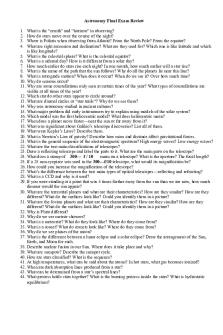Astronomy 114 Exam 2 Review sheet PDF

| Title | Astronomy 114 Exam 2 Review sheet |
|---|---|
| Author | Robert C Spiteri |
| Course | Sun, Stars And Galaxies |
| Institution | Binghamton University |
| Pages | 2 |
| File Size | 62.5 KB |
| File Type | |
| Total Downloads | 101 |
| Total Views | 169 |
Summary
Cheat sheet exam 2. Contains information about the sun adn stars...
Description
The Sun -powered by Nuclear energy (E=mc ) -Nuclear -luminosity- total energy radiated by the sun; Calculated from the fraction of that energy that reaches Earth -Solar constant- amount of sun’s energy reaching earth is About 1400 W/m^2 -Total luminosity- is about 4 x 10^26 W- the equivalent of 10 billion 1-megaton nuclear bombs per second -Radius- 6.9 x 10^8 (109 x Earth) -Mass- 1.99 x 10^30 kg (300000 earths) -Sun is stable because weight of upper layers compresses lower layers -in equilibrium, inward gravitational force must be balanced by outward pressure -energy balance- rate at which fusion releases energy in sun’s core and the rate at which sun’s surface radiates energy into space -solar wind- flow of charged particles from the surface of the sun -corona- outermost layer of solar atmosphere (1 mil K) -chromosphere- middle layer of solar atmosphere (10^4-10^5 K) -photosphere- visible surface of sun (6000 K) -convection zone- energy transported upward by rising hot gas (opaque) -radiation zone- energy transported upward by photons (transparent) -core- energy generated by nuclear fusion (15 mil K) -fission- big nucleus splits into smaller pieces (nuclear power plants) -fusion- small nuclei stick to form bigger one (Sun & stars) - high temps enable nuclear fusion to happen in core -sun releases energy by fusing four H nuclei into 1 He nucleus (proton-proton chain) total mass is .7% lower -energy gradually leaks out of radiation zone in randomly bouncing photons -convection (rising hot gas) brings energy to surface (bright blobs on photosphere) Solar atmosphere -core,radiative zone, convection zone, photosphere,chromosphere, corona -photosphere- visible surface of sun 6k K, highly opaque (H- ions) -sunspots- are cooler regions of photosphere, strong magnetic fields
-solar prominences- gas trapped under giant loops -zeeman effect- measure mag fields w spectral lines -solar flares- caused by mag activity send bursts of x rays in to space -corona- appears bright (mag fields trap gas), high temp, outermost, low density -solar cycle- 11 years before N/S switch(sunspots rise and fall) -maunder minimum- quiet phase of sun 1650-1700 Stars -parallax- the apparent shift in position of nearby object in background of more distant objects -measure stellar distance w trigonometric parallax (depends on dist.) d=1/p -1 parsec= 3.26 light years -barnard’s star has largest proper motion of any star (actual shift in motion of star in sky) -doppler shift only tells motion away or toward -measuring velocity -star brightness depends on both distance and luminosity -luminosity- amt of power a star radiates (energy per sec =watts) -apparent brightness- amt of starlight that reaches Earth (energy per second per square meter) -two stars that appear equally bright may be a closer, dimmer star and a farther, brighter one -luminosity = 4π (distance)^2 x (brightness) -most luminous stars: 10^6 Lsun -least: 10^-4 Lsun -apparent magnitude- how bright a star appears in the sky (smaller mag=brighter star), depends on distance from earth and luminosity {(2.521)^m2-m1 ratio of apparent brightness intensity} -absolute magnitude- brightness measured at 10 parsecs from the Earth - Msun= 4.83 -luminosity=n^(4.83-M) used to compare other stars to the sun -distance modulus- m-M -binary star systems- contain two stars -visual binary star- both stars can be seen directly (and observed) -spectroscopic binary systems- identify through Doppler shifts in spectral lines (toward blue shift, away red shift) -eclipsing binary- orbit in our line of sight. When neither is eclipsed we see both lights. When one eclipses brightness drops because other is covered...
Similar Free PDFs

114 final exam review sheet
- 5 Pages

Astronomy Final Exam Review
- 2 Pages

Exam 2 Review Sheet
- 3 Pages

Review Sheet Exam 2
- 9 Pages

Astronomy cheat sheet exam print
- 3 Pages

NUR 114 Final EXAM Review
- 3 Pages

Astronomy Exam 2
- 2 Pages

Nursing Exam 2 Review Sheet
- 17 Pages

A&P 2- EXAM #2 Review Sheet
- 7 Pages

Exam 1 Review Sheet
- 10 Pages

Exam 1 Review Sheet
- 5 Pages

Exam review sheet - Notes
- 1 Pages

Final Exam Review Sheet
- 12 Pages

Exam Review sheet 3
- 8 Pages

Exam 1 Review Sheet
- 7 Pages
Popular Institutions
- Tinajero National High School - Annex
- Politeknik Caltex Riau
- Yokohama City University
- SGT University
- University of Al-Qadisiyah
- Divine Word College of Vigan
- Techniek College Rotterdam
- Universidade de Santiago
- Universiti Teknologi MARA Cawangan Johor Kampus Pasir Gudang
- Poltekkes Kemenkes Yogyakarta
- Baguio City National High School
- Colegio san marcos
- preparatoria uno
- Centro de Bachillerato Tecnológico Industrial y de Servicios No. 107
- Dalian Maritime University
- Quang Trung Secondary School
- Colegio Tecnológico en Informática
- Corporación Regional de Educación Superior
- Grupo CEDVA
- Dar Al Uloom University
- Centro de Estudios Preuniversitarios de la Universidad Nacional de Ingeniería
- 上智大学
- Aakash International School, Nuna Majara
- San Felipe Neri Catholic School
- Kang Chiao International School - New Taipei City
- Misamis Occidental National High School
- Institución Educativa Escuela Normal Juan Ladrilleros
- Kolehiyo ng Pantukan
- Batanes State College
- Instituto Continental
- Sekolah Menengah Kejuruan Kesehatan Kaltara (Tarakan)
- Colegio de La Inmaculada Concepcion - Cebu
